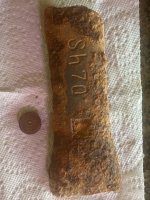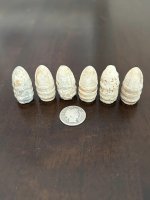Tommi
Sr. Member
- Sep 19, 2005
- 290
- 14
- Detector(s) used
- Famous-Trails-MD9100 ACE250-PRO
- Primary Interest:
- All Treasure Hunting
TWO CANNONS FOUND
Two 19th century cannon, buried on Richmond Oval for more than 60 years, were excavated yesterday They were found in a search on Sunday with equipment owned by an amateur prospector and unearthed by council equipment yesterday morning. Preliminary examinations indicate the cannons are 120 to 180 years old, possibly of Crimean War vintage and of the type issued to many parts of the colony when fears were held of a Russian invasion. The cannons are believed to have been buried about 60 years ago.
Cr. Rex Stubbs, who with Mr. Alex Hendrikson has been coordinating the search, made arrangements with Hawkesbury Shire Council for excavation of the cannon, found a metre inside the oval boundary fence fronting the grandstand.
The search also revealed signs of a third cannon near the Richmond memorial but this was found to be an old water pipe. Sunday's discovery ends a number of unsuccessful searches over the past twelve months for the site of the buried cannons, as reported by a number of long-time residents.
Mr. Henry Gascoigne, 77, of March Street, Richmond, showed Sunday's search party the likely site of the two cannons in front of the grandstand. Their presence was confirmed by metal detectors owned by Mr. Eric Ridgeway, of Wilberforce, an amateur gold prospector who read about the cannon search in last week's Hawkesbury Gazette and offered his services to the search leaders.
The Gazette reported that a search on February 7 by RAAF personnel using detectors had failed to find signs of the cannon around Richmond Oval.
South African-born Mr. Gascoigne recalled several cannons of the muzzle-loading type near the grandstand when he attended Richmond School from 1913 onwards.
"Children used to sit on and play around the guns", he said.
He believes the wooden gun mountings rotted to the stage where they became a hazard to the pupils of the nearby school who used the grandstand surrounds as a playground.
"Brass fittings were taken off the guns and taken to the Richmond council offices, but I have been unable to trace them", Mr. Gascoigne said.
He could not recall the guns being buried but had been told of the spot where holes had been dug and the guns tipped into them when they became a danger to children.
He believes the cannon were buried where they stood because of their weight and lack of machines to move them elsewhere. Mr. Gascoigne took the search party to the spot pointed out to him several years ago as the burial site of the cannons. Within minutes Mr. Ridgeway had readings on his equipment, indicating a metal object three metres long and a metre wide buried less than a metre down on one site.
Mr. Hendrikson, using a rope, traced the outline of a cannon, dictated by the metal detector. A similar exercise produced the outline of another cannon near the oval gate.
"Mr. Gascoigne was fairly accurate in pointing out their sites", Mr. Ridgeway said.
(Hawkesbury Gazette - 27th February, 1985.)
Full story, history, and more information can be found at http://www.hawkesburyhistory.org.au/stubbs/cannons.html
(Remember the technology of a metal detector in 1985 I was 4yrs old so I don't!!!) :P
I was 4yrs old so I don't!!!) :P
Two 19th century cannon, buried on Richmond Oval for more than 60 years, were excavated yesterday They were found in a search on Sunday with equipment owned by an amateur prospector and unearthed by council equipment yesterday morning. Preliminary examinations indicate the cannons are 120 to 180 years old, possibly of Crimean War vintage and of the type issued to many parts of the colony when fears were held of a Russian invasion. The cannons are believed to have been buried about 60 years ago.
Cr. Rex Stubbs, who with Mr. Alex Hendrikson has been coordinating the search, made arrangements with Hawkesbury Shire Council for excavation of the cannon, found a metre inside the oval boundary fence fronting the grandstand.
The search also revealed signs of a third cannon near the Richmond memorial but this was found to be an old water pipe. Sunday's discovery ends a number of unsuccessful searches over the past twelve months for the site of the buried cannons, as reported by a number of long-time residents.
Mr. Henry Gascoigne, 77, of March Street, Richmond, showed Sunday's search party the likely site of the two cannons in front of the grandstand. Their presence was confirmed by metal detectors owned by Mr. Eric Ridgeway, of Wilberforce, an amateur gold prospector who read about the cannon search in last week's Hawkesbury Gazette and offered his services to the search leaders.
The Gazette reported that a search on February 7 by RAAF personnel using detectors had failed to find signs of the cannon around Richmond Oval.
South African-born Mr. Gascoigne recalled several cannons of the muzzle-loading type near the grandstand when he attended Richmond School from 1913 onwards.
"Children used to sit on and play around the guns", he said.
He believes the wooden gun mountings rotted to the stage where they became a hazard to the pupils of the nearby school who used the grandstand surrounds as a playground.
"Brass fittings were taken off the guns and taken to the Richmond council offices, but I have been unable to trace them", Mr. Gascoigne said.
He could not recall the guns being buried but had been told of the spot where holes had been dug and the guns tipped into them when they became a danger to children.
He believes the cannon were buried where they stood because of their weight and lack of machines to move them elsewhere. Mr. Gascoigne took the search party to the spot pointed out to him several years ago as the burial site of the cannons. Within minutes Mr. Ridgeway had readings on his equipment, indicating a metal object three metres long and a metre wide buried less than a metre down on one site.
Mr. Hendrikson, using a rope, traced the outline of a cannon, dictated by the metal detector. A similar exercise produced the outline of another cannon near the oval gate.
"Mr. Gascoigne was fairly accurate in pointing out their sites", Mr. Ridgeway said.
(Hawkesbury Gazette - 27th February, 1985.)
Full story, history, and more information can be found at http://www.hawkesburyhistory.org.au/stubbs/cannons.html
(Remember the technology of a metal detector in 1985
 I was 4yrs old so I don't!!!) :P
I was 4yrs old so I don't!!!) :P




